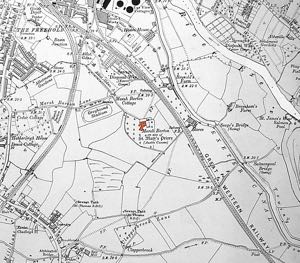
St Mary de Marisco Priory
Marsh Barton Priory
Page updated 13rd August 2015
Just to the north of the present incinerator at Marsh Barton, in Marsh Green Road North, buried under an industrial unit, is the site of the St Mary de Marisco Priory.
The priory seems to have been formed around 1142, as a cell of Plympton. It was a small priory, although it owned a considerable amount of property in and around Exeter, which include:
Land and tenements in the parishes of St. Sidwell, St. Stephen, Allhallows, Goldsmith Street, St. Paul, St. Pancras, St. Martin, St. Petrock (two tenements and four shops in High Street), St. Kerrian (two tenements, a stable and garden), St. Olave (two tenements and four shops), St. Mary Arches, "Coke Rew," St. Mary Major, Holy Trinity, St. George, and St. Mary Steps. The houses, shops, and small pieces of land in these parishes, and in " Coke Rew," near the Conduit, which produced an annual income of £23 12s, 7d.
In Alphington the monks had about seventeen acres of land, land beyond Exminster, and several houses and gardens, worth £1 8s, 4d. a year. In Heavitree they owned four acres of land, near the road, towards the village, "between the Granary of Henry Hule and that of the Prior of St. James', near the Marsh." In the immediate neighbourhood of the St James Priory, they held another four acres. The total rental due of "Marescombe, nigh the city of Exeter," was, £28 8s. 11d. clear of all deductions.
In 1815 Jenkins recorded that the priory “was situate in a deep fenny soil, surrounded with ditches; here was a small Priory of Black Canons; some part of the building still bears the appearance of antiquity.”
It was a house of Augustinian Canons, of which the names of four Superiors, or ‘Custodes’ have been recorded. One such Superior, was Thomas Cryer, who is remembered from the following anecdote in Worthy’s Suburbs of Exeter. “The cook of the priory assaulted him with a drawn dagger, and Cryer knocked him down with a stick, and inflicted a severe wound on his head, from the effects of which he died three days afterwards.” Bishop Stafford declared Cryer free of prosecution (5 September 1409), and allowed him to resume his role as the Superior of the priory.
The Priory is Dissolved
The priory was dissolved by Henry VIII in 1539 and given, in 1546, to James Coffin and Thomas Godwin. Coffin built himself a mansion in 1562. Part of the chapel of the priory was demolished by Coffin, and the timber and stones used for the rebuilding, of St. Paul's Church, in the city. He also sold to John Hoker (Hooker), the City Chamberlain:
“all the trees, oak, ash, elm, &c., &c., standing, in the grove at the south side of "Marsh mansion house," between the running water on the south, and the open pasture, adjoining the said mansion, on the north, the great pool on the west, and a ditch on the east. For these, and some other oak trees, standing on the south-east of the mansion, Hoker paid £27.” (Worthy)
Hoker is chiefly remembered for his Chronicle of Exeter, when he attempted to list all of Exeter’s mayors, along with notes about them.
Moving forward to 1822, and Richard Pyne-Coffin of Portledge was the owner of Marsh Barton. In the 20th Century it was recorded as a very ordinary dilapidated farmhouse, on the newly constructed Marsh Barton trading estate. It was soon demolished to make way for more industrial units.
Sources: Historic England, Jenkins's Civil And Ecclesiastical History of the City Of Exeter And its Environs, The History of the City Of Exeter, by the Rev. George Oliver, D.D.

 The old farmhouse that was the remnant of the Priory
is below the stadium, in the dark field. This aerial photo was taken about 1946. Photo by Bertram 'Johnnie' Arden.
The old farmhouse that was the remnant of the Priory
is below the stadium, in the dark field. This aerial photo was taken about 1946. Photo by Bertram 'Johnnie' Arden.
│ Top of Page │